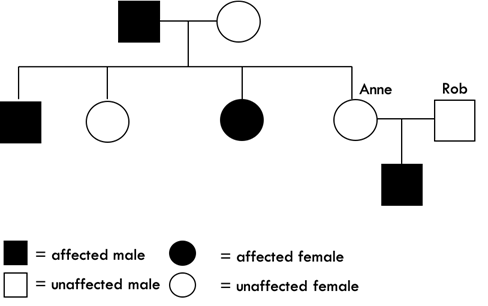Week 13 Lectorial Questions
Haemophilia is a genetic bleeding disorder where essential blood clotting proteins are missing or defective. People with this disorder experience prolonged bleeding following surgery or injury and in severe cases, spontaneous internal bleeding. The pedigree below indicates the presence of haemophilia in 3 generations of a family.

Q1. The child of Anne and Rob is an affected haemophiliac male. One of his parents was a carrier of the disease. Explain what is meant by a carrier. (50 words or fewer) (1 mark)
Q2. Explain why haemophilia is more prevalent in males than females. (50 words or fewer) (1 mark)
Q3. If Anne and Rob have a second son, what is the probability that he will also have haemophilia? Complete a Punnett square to show your working. (2 marks)
Many people diagnosed with haemophilia in adulthood come from families with no previous history of the condition.
Q4. Explain how it is possible to have haemophilia without having the condition inherited. (50 words or fewer) (1 mark)
Q5. Haemophilia is often detected in adulthood following surgery. Propose strategies that could be used by the medical team to prevent excessive blood loss from prolonged bleeding. (100 words or fewer) (2 marks)
Q6. Some women are diagnosed as "symptomatic carriers" and show signs of moderate to severe haemophilia. Research and explain how this is possible. (100 words or fewer) (3 marks)